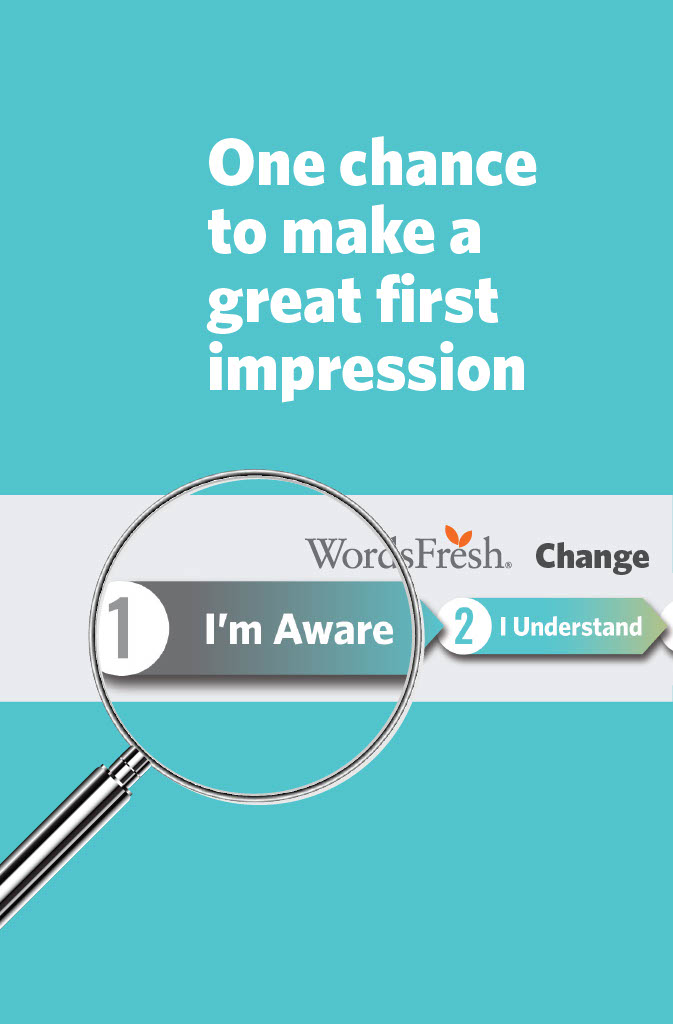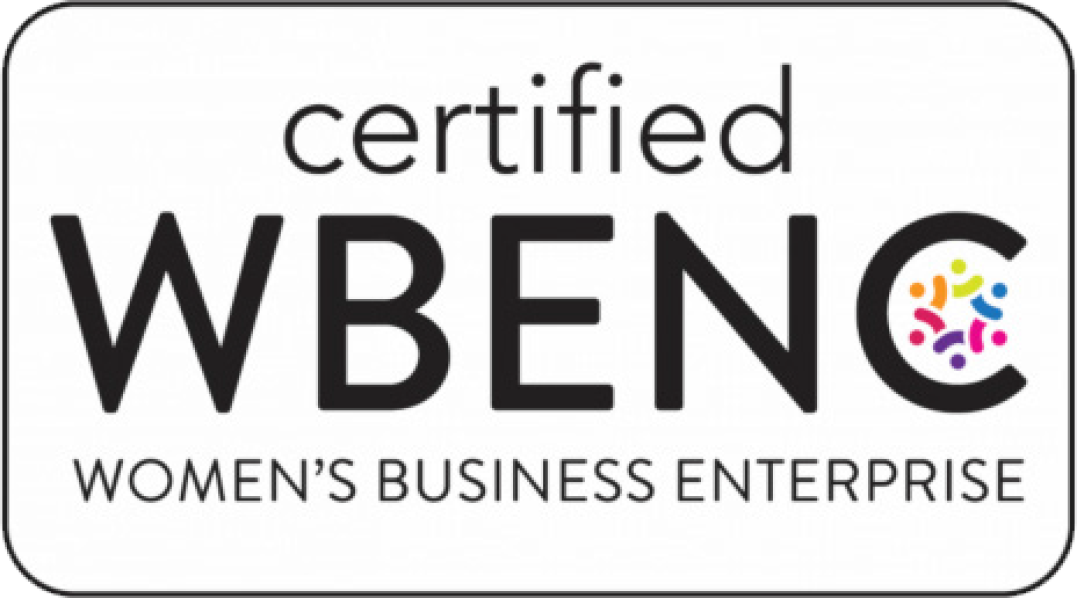
When a big change is about to happen in a company – and let’s face it, change always happens – there’s a critical moment that leads to either success or failure.
In this moment,
- the change will take root and eventually be supported by employees, managers and leaders, or
- it will be forgotten with the rest of last year’s “priorities” that never gained traction
What is this critical moment? Often, it’s the first time an employee becomes aware a change is happening.
Undoubtedly, much time, effort and investment have gone into creating the change program itself. But the success of any change program is directly proportional to the communications you create.
Over our decades of experience working with major players in internal communications, we’ve helped with strategic communications that have led to some amazing cultural and behavioral changes.
And each one of those began with a strategic campaign line.
You have one chance to make a great first impression
At WordsFresh, we developed a Change Communications Model to help clients think through their strategy. We’ve found that this model helps keeps employees at the forefront of planning.
The four steps of our Change Communications Model are:
- I’m Aware
- I Understand
- I Act
- I Grow
For the I’m Aware stage, a strategic campaign line is a key component. It’s typically the first communication employees see about the change, setting the tone and focus for all communications that follow.
Employees feel heard and supported when communications align with their needs in each step of the Change Communications Model, leading to measurable results.

Make your communications more than the sum of their parts
Budgets are tight, and every single communication tactic must pull its weight. Yet, the challenges are immense.
You have multiple audiences, each probably needing different messages often delivered through various channels.
You may have some employees who don’t work in front of computers at all, making them particularly hard to reach.
You or your team may already have tactics in mind. The leadership team may have additional ideas. And don’t forget the hundreds of other things happening at your company that are shouting for attention.
Across all this complexity, a single strategic campaign line brings simplicity and power.
It’s simple because it distills your point of view. It delivers that key point every time, in every channel, each time any related information is conveyed. It makes life easier for you and your team by simplifying the focus of all subsequent communications. And it’s incredibly powerful.
How? Rather than struggling to “connect the dots” among various communications, employees begin to recognize the theme. Each time they receive a new communication, they aren’t starting from zero. They’re grounded and maybe even inspired.
It could also be the most strategic budget move you make. The line becomes shorthand for delivering your key message repeatedly and consistently.

Turn change into an opportunity
Occasionally, someone tells us a campaign line is overkill. Just tell employees what they need to do!
That’s a big lost opportunity.
A campaign line can do even more than support a single initiative. Here’s a chance for engagement, pride and excitement as the team learns the philosophy behind the change and how it will make the company stronger. Even if it’s not the best news for everyone.
All of this can directly impact employee retention, even in a tight labor market. If that’s not reason enough, the actual process of creating a campaign line can rally the leadership team and help you become crystal clear about your strategy.
The truth is, many of the steps to creating a campaign line must be taken anyway to create your communications plan. Why not take a few extra steps to develop a campaign line?
And if you need help with that, we know an agency (it’s us….WordsFresh) that has extensive experience in that area. Just email our president Mary Pat Nimon to get started.

When a big change is about to happen in a company – and let’s face it, change always happens – there’s a critical moment that leads to either success or failure.
In this moment,
- the change will take root and eventually be supported by employees, managers and leaders, or
- it will be forgotten with the rest of last year’s “priorities” that never gained traction
What is this critical moment? Often, it’s the first time an employee becomes aware a change is happening.
Undoubtedly, much time, effort and investment have gone into creating the change program itself. But the success of any change program is directly proportional to the communications you create.
Over our decades of experience working with major players in internal communications, we’ve helped with strategic communications that have led to some amazing cultural and behavioral changes.
And each one of those began with a strategic campaign line.
You have one chance to make a great first impression
At WordsFresh, we developed a Change Communications Model to help clients think through their strategy. We’ve found that this model helps keeps employees at the forefront of planning.
The four steps of our Change Communications Model are:
- I’m Aware
- I Understand
- I Act
- I Grow
For the I’m Aware stage, a strategic campaign line is a key component. It’s typically the first communication employees see about the change, setting the tone and focus for all communications that follow.
Employees feel heard and supported when communications align with their needs in each step of the Change Communications Model, leading to measurable results.

Make your communications more than the sum of their parts
Budgets are tight, and every single communication tactic must pull its weight. Yet, the challenges are immense.
You have multiple audiences, each probably needing different messages often delivered through various channels.
You may have some employees who don’t work in front of computers at all, making them particularly hard to reach.
You or your team may already have tactics in mind. The leadership team may have additional ideas. And don’t forget the hundreds of other things happening at your company that are shouting for attention.
Across all this complexity, a single strategic campaign line brings simplicity and power.
It’s simple because it distills your point of view. It delivers that key point every time, in every channel, each time any related information is conveyed. It makes life easier for you and your team by simplifying the focus of all subsequent communications. And it’s incredibly powerful.
How? Rather than struggling to “connect the dots” among various communications, employees begin to recognize the theme. Each time they receive a new communication, they aren’t starting from zero. They’re grounded and maybe even inspired.
It could also be the most strategic budget move you make. The line becomes shorthand for delivering your key message repeatedly and consistently.

Turn change into an opportunity
Occasionally, someone tells us a campaign line is overkill. Just tell employees what they need to do!
That’s a big lost opportunity.
A campaign line can do even more than support a single initiative. Here’s a chance for engagement, pride and excitement as the team learns the philosophy behind the change and how it will make the company stronger. Even if it’s not the best news for everyone.
All of this can directly impact employee retention, even in a tight labor market. If that’s not reason enough, the actual process of creating a campaign line can rally the leadership team and help you become crystal clear about your strategy.
The truth is, many of the steps to creating a campaign line must be taken anyway to create your communications plan. Why not take a few extra steps to develop a campaign line?
And if you need help with that, we know an agency (it’s us….WordsFresh) that has extensive experience in that area. Just email our president Mary Pat Nimon to get started.
 SUBSCRIBE TO
SUBSCRIBE TO
Three fresh ideas (and a meme)
Love what you just read? There’s more! Sign up for our monthly newsletter for even more thought-provoking ideas (and reasons to LOL).


